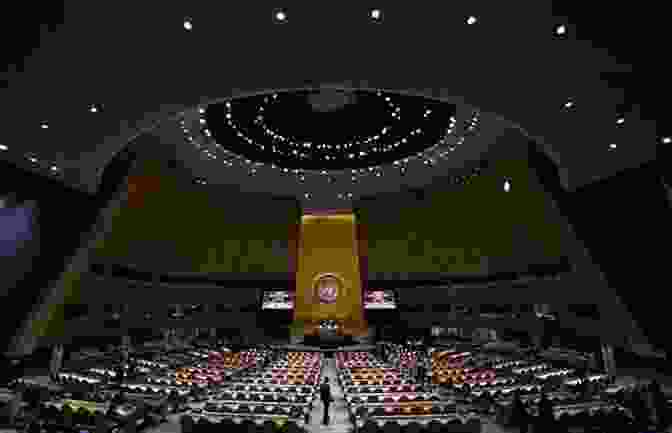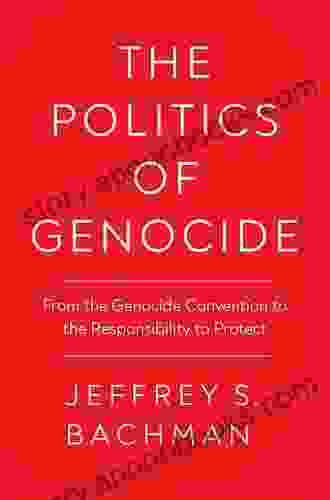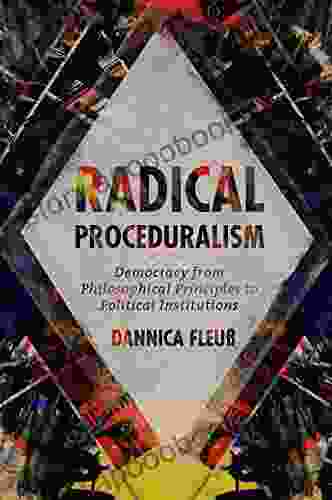From the Genocide Convention to the Responsibility to Protect: A Comprehensive Guide

The Genocide Convention, adopted in 1948, was a landmark achievement in international law. It defined genocide as a crime under international law and established a framework for its prevention and punishment. However, the Convention proved to be insufficient in preventing subsequent genocides, such as the Holocaust in Cambodia and the Rwandan Genocide.
In response to these failures, the United Nations adopted the Responsibility to Protect (R2P) in 2005. R2P is a norm that places a responsibility on states to protect their populations from genocide, war crimes, ethnic cleansing, and crimes against humanity. It also provides a framework for international intervention when a state is unable or unwilling to protect its own population.
4.7 out of 5
| Language | : | English |
| File size | : | 20124 KB |
| Text-to-Speech | : | Enabled |
| Screen Reader | : | Supported |
| Print length | : | 313 pages |
| Paperback | : | 60 pages |
| Item Weight | : | 3.68 ounces |
| Dimensions | : | 6 x 0.15 x 9 inches |
This comprehensive guide explores the evolution of international law from the Genocide Convention to the Responsibility to Protect. It provides a detailed analysis of the Genocide Convention, its shortcomings, and the development of R2P. The guide also examines the challenges of implementing R2P and the role of the international community in preventing and punishing genocide.
The Genocide Convention
The Genocide Convention was adopted by the United Nations General Assembly on December 9, 1948. It defines genocide as "any of the following acts committed with intent to destroy, in whole or in part, a national, ethnical, racial or religious group, as such:
- Killing members of the group;
- Causing serious bodily or mental harm to members of the group;
- Deliberately inflicting on the group conditions of life calculated to bring about its physical destruction in whole or in part;
- Imposing measures intended to prevent births within the group;
- Forcibly transferring children of the group to another group.
The Genocide Convention also establishes a framework for the prevention and punishment of genocide. It requires states to enact laws criminalizing genocide and to cooperate with other states in preventing and punishing the crime. The Convention also establishes the International Court of Justice as the competent tribunal for trying individuals accused of genocide.
Shortcomings of the Genocide Convention
Despite its landmark status, the Genocide Convention has been criticized for its shortcomings. One of the most significant criticisms is that the Convention is too narrow in its definition of genocide. It only applies to acts committed with the intent to destroy a group "in whole or in part." This means that acts of mass violence that do not have the intent to destroy a group, such as ethnic cleansing, are not considered genocide under the Convention.
Another criticism of the Genocide Convention is that it is difficult to enforce. The Convention requires states to cooperate with each other in preventing and punishing genocide, but it does not provide any specific mechanisms for enforcement. This has made it difficult to hold states accountable for their failure to prevent or punish genocide.
The Responsibility to Protect
In response to the shortcomings of the Genocide Convention, the United Nations adopted the Responsibility to Protect (R2P) in 2005. R2P is a norm that places a responsibility on states to protect their populations from genocide, war crimes, ethnic cleansing, and crimes against humanity. It also provides a framework for international intervention when a state is unable or unwilling to protect its own population.
R2P is based on the principle that every state has a responsibility to protect its own population. However, if a state is unable or unwilling to protect its population, the international community has a responsibility to intervene to protect civilians. This responsibility is known as the "responsibility to protect" (R2P).
R2P was adopted by the United Nations General Assembly in 2005. It is not a legally binding treaty, but it is a widely accepted norm in international law. R2P has been used to justify international intervention in a number of cases, including the intervention in Libya in 2011.
Challenges of Implementing R2P
There are a number of challenges to implementing R2P. One of the most significant challenges is the issue of sovereignty. States are generally reluctant to give up their sovereignty, and they may be resistant to international intervention, even when it is necessary to protect civilians.
Another challenge to implementing R2P is the issue of resources. International intervention can be expensive and time-consuming. This can make it difficult to sustain international intervention over the long term.
The Role of the International Community
The international community has a role to play in preventing and punishing genocide. The international community can help to prevent genocide by providing early warning of potential genocides and by providing assistance to states that are at risk of genocide. The international community can also help to punish genocide by prosecuting those responsible for the crime and by providing support to victims of genocide.
The international community has a responsibility to protect civilians from genocide and other mass atrocities. This responsibility is based on the principle of humanity and the recognition that all human beings have the right to live in peace and security. The international community must work together to implement R2P and to ensure that the world is free from genocide.

4.7 out of 5
| Language | : | English |
| File size | : | 20124 KB |
| Text-to-Speech | : | Enabled |
| Screen Reader | : | Supported |
| Print length | : | 313 pages |
| Paperback | : | 60 pages |
| Item Weight | : | 3.68 ounces |
| Dimensions | : | 6 x 0.15 x 9 inches |
Do you want to contribute by writing guest posts on this blog?
Please contact us and send us a resume of previous articles that you have written.
 Book
Book Novel
Novel Page
Page Chapter
Chapter Text
Text Story
Story Genre
Genre Reader
Reader Library
Library Paperback
Paperback E-book
E-book Magazine
Magazine Newspaper
Newspaper Paragraph
Paragraph Sentence
Sentence Bookmark
Bookmark Shelf
Shelf Glossary
Glossary Bibliography
Bibliography Foreword
Foreword Preface
Preface Synopsis
Synopsis Annotation
Annotation Footnote
Footnote Manuscript
Manuscript Scroll
Scroll Codex
Codex Tome
Tome Bestseller
Bestseller Classics
Classics Library card
Library card Narrative
Narrative Biography
Biography Autobiography
Autobiography Memoir
Memoir Reference
Reference Encyclopedia
Encyclopedia Peter Wortsman
Peter Wortsman Natalia Bonner
Natalia Bonner Osho
Osho Natalee Alex
Natalee Alex Luca R Joahnson
Luca R Joahnson Sir Arthur Wing Pinero
Sir Arthur Wing Pinero H J Marshall
H J Marshall Revised Edition Kindle Edition
Revised Edition Kindle Edition Omar Prakash
Omar Prakash Kirk Williams
Kirk Williams Robert E Guarino
Robert E Guarino Laurence Holder
Laurence Holder Malcolm D Holmes
Malcolm D Holmes Rhett C Bruno
Rhett C Bruno Max Smith
Max Smith Max Dorfer
Max Dorfer Lisa Betz
Lisa Betz Val M Runge
Val M Runge Tim Seeley
Tim Seeley Tyler W Kurt
Tyler W Kurt
Light bulbAdvertise smarter! Our strategic ad space ensures maximum exposure. Reserve your spot today!

 Ian MitchellUnveiling the Treasures of "Favorite Gospel Tunes for Banjo": A Captivating...
Ian MitchellUnveiling the Treasures of "Favorite Gospel Tunes for Banjo": A Captivating...
 Blake KennedyPhotographs of the Natural Beauty of the Earth: A Captivating Journey through...
Blake KennedyPhotographs of the Natural Beauty of the Earth: A Captivating Journey through... VoltaireFollow ·7.8k
VoltaireFollow ·7.8k Dylan MitchellFollow ·16.2k
Dylan MitchellFollow ·16.2k Billy PetersonFollow ·19.7k
Billy PetersonFollow ·19.7k Jackson HayesFollow ·2.7k
Jackson HayesFollow ·2.7k Allan JamesFollow ·6.9k
Allan JamesFollow ·6.9k Jeremy MitchellFollow ·8.6k
Jeremy MitchellFollow ·8.6k Peter CarterFollow ·9.2k
Peter CarterFollow ·9.2k Darren NelsonFollow ·16.6k
Darren NelsonFollow ·16.6k

 Jorge Luis Borges
Jorge Luis BorgesUnlock Your Inner Musician: The Ultimate Guide to...
Embark on a Musical...

 Carlos Drummond
Carlos DrummondQuick Reference Guide To Percussion Instruments And How...
Unleash your inner rhythm with...

 Roberto Bolaño
Roberto BolañoUnlock Your Guitar Potential: The Ultimate Guitar Mastery...
Are you ready...

 Fred Foster
Fred FosterLooking for Lady Dee: A Punk Rock Mystery
By [Author's Name] Looking for Lady Dee is...

 Jacques Bell
Jacques BellJourney into the Mystical Realm of "Heaven Polly Alice...
In the tapestry of literature, where...

 Julio Ramón Ribeyro
Julio Ramón RibeyroSixty Years of Hits: A Musical Journey Through Time
Music has the...
4.7 out of 5
| Language | : | English |
| File size | : | 20124 KB |
| Text-to-Speech | : | Enabled |
| Screen Reader | : | Supported |
| Print length | : | 313 pages |
| Paperback | : | 60 pages |
| Item Weight | : | 3.68 ounces |
| Dimensions | : | 6 x 0.15 x 9 inches |








